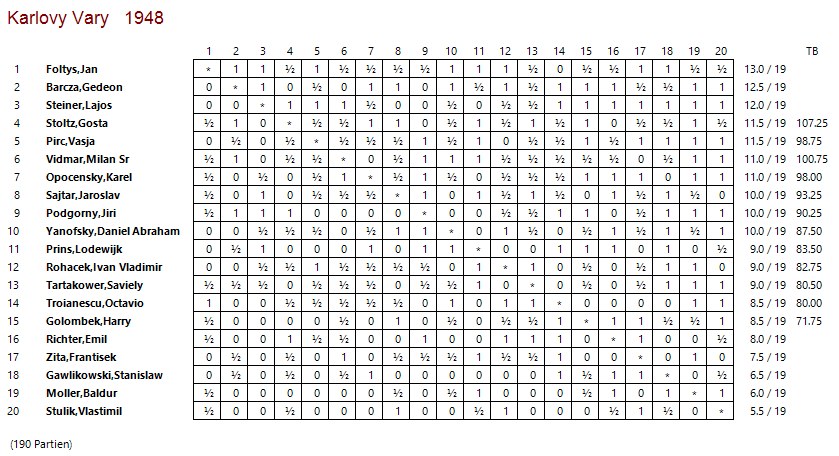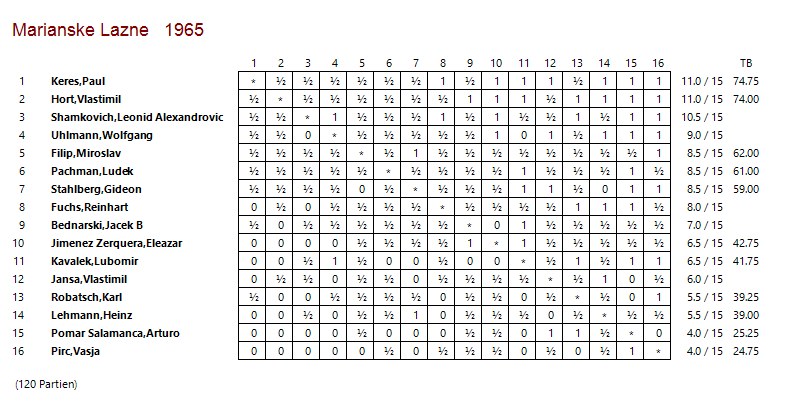Vasja Pirc
December 19th, 1907 to June 2nd, 1980
Was Vasja Pirc a thoroughbred chess professional? Barely. Similar to Milan Vidmar, he always kept a door open to civilian life. Though a professor of history and geography in Ljubljana, he also wanted to achieve something in chess, like his role model Adolf Anderssen from Breslau, who was celebrated enthusiastically after his victory at the tournament in London in 1851, and applauded with "Viva Anderssen".
The beginning was promising: Rogaška Slatina, 1929. The tournament is considered an overture to the Balkan chess boom, which started in Slovenia, spread to Croatia and later reached Serbia and Macedonia.

Pirc ended the tournament with a split 3rd-5th place, among good company.

But then came the damper — Bled 1931. Alexander Alekhine was in the form of his life at this tournament. Pirc came in last, but that only served to motivate him more. Tito's Yugoslavia did not exist yet and the policy of socialist self-government, which promoted the chess movement everywhere, was still around 20 years away.
Vasja Pirc was an autodidact and his career is fascinating: He took part in the Chess Olympiads of 1931, 1935, 1937, 1950, 1952 and 1954. He was also present in Munich, 1936. In Dubrovnik in 1950, the Yugoslav team brought home the gold. They won bronze in 1952 in Helsinki and 1954 in Amsterdam. In 1938, Pirc was the first reserve player for the AVRO tournament in Holland and he was one of the ten best players in the world. An interesting competition between Max Euwe and Vasja Pirc, played in Bled in 1949, ended in a 5 : 5 tie. Vasya Pirc really did not need to hide from anyone.

Between 1935 and 1953 Pirc was five-time Slovenian, or Yugoslavian individual champion and played on the first board for the team of his hometown club in Ljubljana, in 1955 and 1956, scoring 4½ out of 7 on both occasions.
Vasja Pirc was also a good chess journalist. He spoke German and English well. His contribution to the opening theory is well known and clear: the Pirc defense (sometimes known as the Ufimtsev or Yugoslav Defense) — more on that below.
Vasja Pirc must have loved the Czech baths very much. Podebrady 1936 was probably the strongest tournament on Czech soil in the first half of the 20th century. Pirc also played the tournament in Karlovy Vary in 1948 and was back in Mariánské Lázně in 1965.
The crosstables are extremely interesting. Sometimes Pirc played well, othertimes less so:



Pirc (left) against Bouwmeester at the Hoogoven tournament in 1954. Euwe starts the clock.

I was curious about times when Pirc played the defense named after him and scoured the tournament books. To my disappointment, I found only one game in which he used the defense himself. Instead, Pirc preferred the Caro-Kann rather than his own invention.
In the positional systems White does not try to refute the Pirc from the very first moves, but aims for a long strategic battle to prove that his space advantage and better development will finally give him the better position.
In his little book "Novejsa teorija Šahovska otvoritev" ("New Theory of Chess Openings"), I found a chapter by the author listed as "Pirceva obramba" ("Pirc's Defense"). I was lucky enough to meet Vasja Pirc in person at the 1965 Marianske Lazne tournament. He and his colleague Gideon Stahlberg (* 1908) walked diligently in the morning, received a massage here and enjoyed the blessings of the healing springs there. In the afternoon chess was played and in the evening — presumably against any medical order — wine (Pirc), beer and schnapps (Stahlberg) was consumed.
In search of more Pirc games played by the man himself, I found the game Rossolimo (France) — Pirc (Yugoslavia) Dubrovnik, 1950, where the master obliged:
Finally, his tournament book about the Staunton Memorial 1951 is a wonderful book and was very important for the development of chess throughout the Balkans.
Correction December 21st: Yugoslavia won bronze at the 1952 and 1954 Olympiads, not silver as originally stated.
The resulting positions are usually dynamic or double-edged and offer fairly balanced chances. The better tactician may win, but do not be dissappointed if the game ends in a spectacular and logical draw!






























